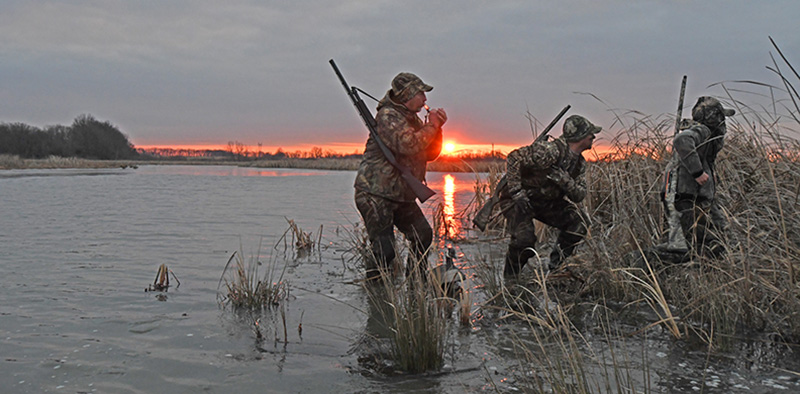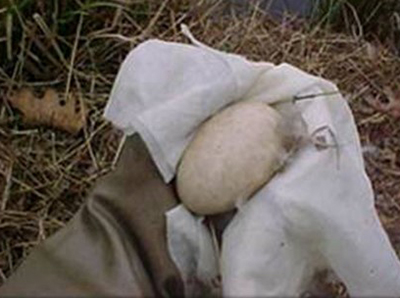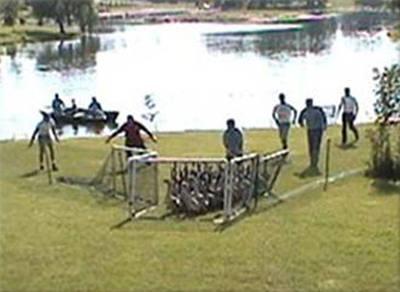Canada Geese Management
Introduction | Human & Habitat Modification | Harassment, Hunting & Permits | Questions & Answers
Harassment
Harassment techniques are used to frighten and discourage geese from using a property. They are non-lethal and it is legal to harass Canada geese without a federal or state permit as long as they are not injured, touched, or handled by a person, dog, or other equipment. Different harassment methods can entail audial, visual, and physical techniques so long as local ordinances are being followed.
Harassment techniques will only be as effective as the amount of effort employed. Harassment techniques must be used repetitively each time geese appear on your property to be successful. Geese should be harassed as soon as they appear on a property as they are much more difficult to frighten after they feel comfortable in an area.
The following techniques may be used to harass geese, where safe and legal to do so. Check local ordinances and laws before using techniques.
Audial Devices
- Air horns
- Whistles
- Blank pistols
- Specialized projectiles (bangers, screamers, and whistlers)
- Cracker shells from a shotgun
- Firecrackers
- Propane cannons
- Recorded distress calls
Visual Devices
- Motion sensor lights
- Flagging
- Eye spot balloons
- Dead goose or predator decoys
- Mylar tape
- Scarecrows
- Dogs (chasing only)
- Remote controlled devices
- Hand held lasers
Physical Devices
- Garden hose
- Sprinkler
- Motion-activated sprayer
- Legal chemical repellents (must be applied following label instructions)
Hunting

Hunting waterfowl, where safe and following local ordinances, should be encouraged during the legal waterfowl hunting seasons using legal methods. Hunting is the most effective and preferred method of removing surplus ducks and geese. Hunting also removes some of the adult breeding birds that are adding to the population.
Egg and Nest Destruction

Nest removal can be carried out, at any time, as long as no eggs are present. Repeatedly removing nesting can encourage breeding geese to relocate, build a new nest, or nest later in the season. It is encouraged to begin nest removal as soon as geese are seen scouting nest locations and to prevent them from laying eggs in undesirable locations. Nest construction may last for several weeks and the first egg may be laid less than 24 hours after the nest is constructed. Once the first egg is laid in a nest, no further action can be taken without first registering online with the United States Fish and Wildlife Service.
It is against federal law for anyone to destroy a Canada goose nest that contains one or more eggs without first securing permission through the United States Fish and Wildlife Service. Permission may be received by registering online. Landowners must register each employee or agent working on their behalf. Egg destruction can be implemented March 1 through June 30.
Once registered, egg treatment or nest destruction can occur. Be cautious if attempting to conduct these activities yourself as Canada geese are very aggressive during the nesting period and may attack a person coming close to their nest. A person may either shake the egg for at least 60 seconds, puncture the large end of the egg with a sharp object, or coat the egg with corn oil to prevent it from hatching. Only eggs that are over 14 days old and float in the water float test should be removed from the nest. If the eggs are removed or broken too early the goose will lay more eggs.
The eggs can be treated by using food-grade corn oil and placed back in the nest. This will trick the goose into sitting on the eggs for an extended time, but they will not hatch. The oil blocks the pores on the eggshell and the egg becomes unviable.
Nest removal with eggs present is an effective way to reduce goose reproduction and reduce the local goose population in the long-term. If the goose can be seen on the nest, remove the nest after she has been sitting on her eggs for 14 days. If the nest is taken earlier, she is likely to re-nest and lay new eggs, so it is important to wait for 14 days after the last egg is laid. It is probably better to leave the eggs a few days longer than two weeks, rather than take them too early.
March through April are primary egg laying times for geese when egg destruction methods should be used. These times may vary depending on spring temperatures and other local conditions. Nests with cold eggs should be left alone, because the goose is still laying eggs. Return two weeks later to remove any nests that are cold on the first attempt. The entire nest and all eggs should be removed and placed in garbage bags. These can be sent to a landfill.
A method you can use to help you age the Canada geese eggs more accurately is the float test. Take the eggs and put them in a bucket with at least 6 inches of water. Eggs younger than 14 days will sink. These eggs should be dried off, addled, and returned to the nest. Eggs that are older than 14 days will float. These eggs should be removed unless the eggshell is pipped, which means the gosling is pecking through and ready to hatch. Leave all the eggs in a nest when one egg is pipped. All the goslings will be hatching within a few hours. Removal of live geese including goslings requires a separate permit.
Depredation and Trapping Permits

It is illegal to trap and relocate or euthanize geese without a permit from a District Wildlife Biologist. Landowners that wish to conduct goose management activities must contact a District Wildlife Biologist to receive a waterfowl permit request for review prior to receiving a trap and relocate or euthanize permit. Geese causing damage in the amount of $500 or more needs to be documented on the permit request form.
Trapping will only be conducted during the bird’s flightless period (molt), which occurs from about mid-June through early July. The only exception is if a human safety or health hazard exists. If a Trap and Relocate permit is obtained, landowners can trap and relocate geese themselves or hire qualified Waterfowl Control Operators (WCO) to provide the service. All WCOs name their own rates and fees. Information on traps, proper handling of birds, and transport equipment will be provided by the biologist. All geese must be relocated to an approved area designated by the Division of Fish & Wildlife.
The relocation of Canada geese will only alleviate goose conflicts for a short time. It is not a long-term solution. Geese have strong homing instincts and often return to the area where they learned to fly, even after being relocated hundreds of miles away.
Landowners may also apply for a Trap and Euthanize permit. Again, trapping will only occur during molt. Once a Trap and Euthanize permit is obtained, landowners or public managers must contract a qualified WCO to provide the service. Adult birds will be transported off site and euthanized according to American Veterinary Medical Association standards. Euthanized geese may be donated for human consumption.
This method does remove adult breeders from the population, which will decrease the number of birds in that local area. However, other geese may move into the now available habitat. Landowners wanting to use this measure should display a willingness to use other abatement techniques including harassment, habitat modification, and egg and nest destruction to prevent geese from becoming a problem in the future.
Farmers experiencing crop damage greater than $500 by Canada geese may request a Depredation Permit from their District Wildlife Biologist following the same process of filling out a permit request form. Non-lethal techniques must be utilized during this same time. The permits allow shooting of depredating Canada geese outside of the normal hunting season.
Domestic Geese
Domestic geese are not regulated by the Indiana Department of Natural Resources.
